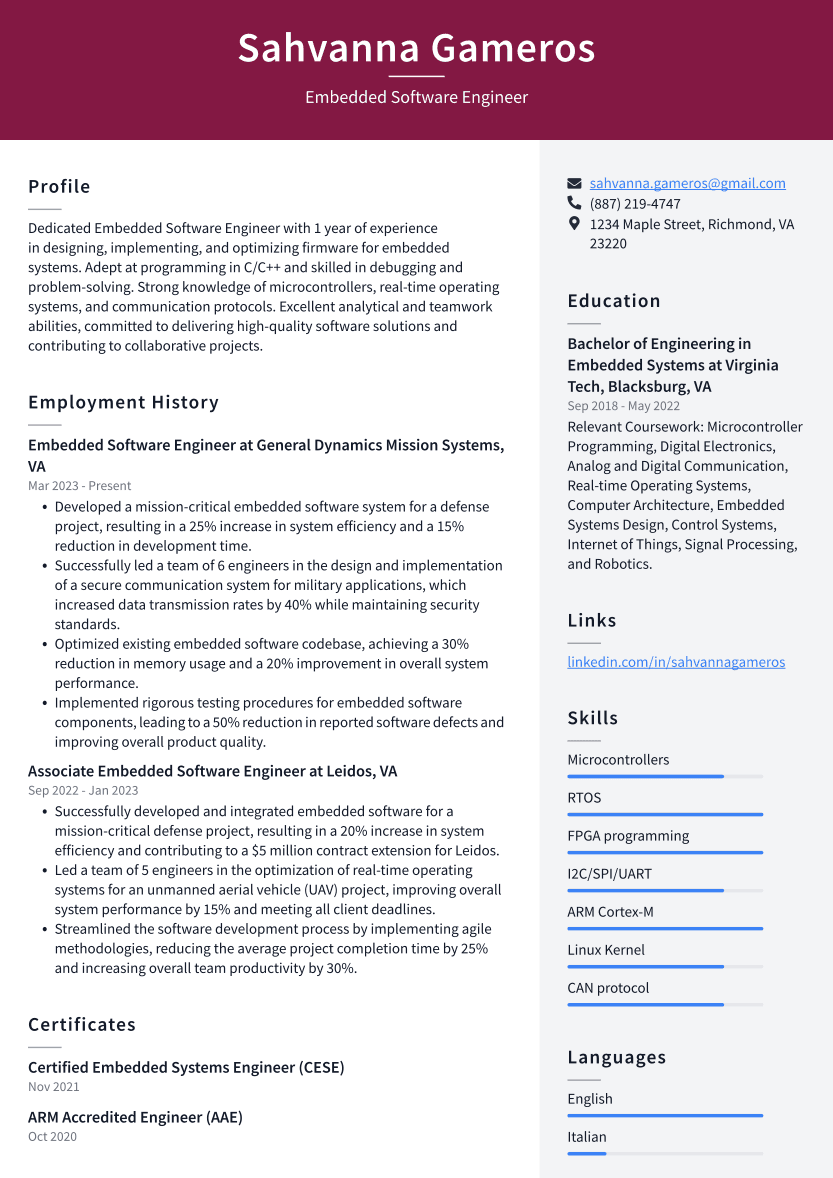Embedded Software Engineer Resume Examples
Writing a great embedded software engineer resume is important because it is one of the first things a potential employer will see when they are considering you for a position. It is your opportunity to make a good first impression and sell yourself as the best candidate for the job.
Create your resume
Select from 7 professional resume templates
If you're looking for inspiration when it comes to drafting your own embedded software engineer resume, look no further than the samples below. These resumes will help you highlight your experience and qualifications in the most effective way possible, giving you the best chance of landing the embedded software engineer job you're after.
Essential Components of an Embedded Software Engineer's Resume
An effective resume for an Embedded Software Engineer is a critical tool in showcasing their expertise, work history, and value they can add to a company. A well-crafted resume should highlight their suitability for the role with precision and clarity.
It's essential to demonstrate proficiency in embedded systems, programming languages, and problem-solving capabilities. Below, we delve into the essential sections of a resume, offering guidance on how to make each segment stand out to capture the attention of hiring managers in this specialized field.
Contact Information
At the top of your resume, ensure your contact information is prominently displayed, accurate, and up-to-date. This includes your full name, a professional email address, and a reliable contact number. Indicate your preferred method of communication if you have one.
Consider including your general location if the job is in a different area, and add links to professional online profiles like LinkedIn or GitHub to provide a more comprehensive view of your accomplishments. However, omit personal details such as age or marital status to maintain professionalism and privacy.

Objective Statement
The Objective Statement is a succinct summary of your career goals and the unique skills you bring to the table. Tailor this statement to each job application, highlighting your expertise in areas such as coding languages, experience with microcontroller platforms, and your ability to integrate hardware and software.
An example of a compelling objective statement might be: "Detail-oriented Embedded Software Engineer with a strong background in C++ and ARM Cortex-M microcontrollers, seeking to leverage my technical skills to contribute to innovative solutions at XYZ Company."
Skills and Proficiencies
List the technical skills and proficiencies that are most relevant to the job you're applying for, such as:
- Coding languages (C, C++, Python, Java, Assembly)
- Microcontroller architecture (ARM Cortex-M, AVR)
- Real-Time Operating Systems (RTOS) like FreeRTOS or VxWorks
- Debugging tools (GDB, JTAG debuggers)
- Hardware/software integration (SPI, I2C, UART)
- Version control systems (Git)
- FPGA/VHDL/Verilog experience
- Problem-solving and communication skills
- Project management methodologies (Agile, Scrum)
Align this section with the job description to ensure you're showcasing the skills that are most in demand for the role.
Work Experience
Detail your relevant work experience, including job titles, companies, duration of employment, and key responsibilities and achievements. Use bullet points for clarity and quantify your accomplishments where possible. Highlight any leadership roles or collaborative projects to demonstrate teamwork and leadership potential.
Recruiters often scan resumes quickly, so it's crucial to make this section easily digestible while emphasizing the experiences that align with the job requirements.
Education and Certifications
Outline your educational background, including degrees, institutions, and graduation dates. Include certifications such as Certified Software Development Professional (CSDP) or Microsoft Certified: Azure AI Engineer Associate, which can bolster your qualifications and show a commitment to professional development.
Also, mention any specialized training or courses relevant to embedded systems that could enhance your candidacy.
Projects and Achievements
Use this section to showcase your hands-on experience with detailed descriptions of projects you've led or contributed to, the technologies used, and the outcomes achieved. Include academic or internship projects if they demonstrate relevant skills and passion for the field.
Highlight significant accomplishments, such as awards or recognitions, and provide quantifiable metrics to give a clear picture of your impact.
References
References can serve as a testament to your skills and work ethic. Choose individuals who can vouch for your technical abilities and professional qualities. Always obtain their consent before listing them and ensure their contact information is current.
Alternatively, you can state that references are available upon request, but having them prepared can show initiative and preparedness.
While the 'References' section may not be as immediately impactful as 'Skills' or 'Experience,' it plays a crucial role in validating your credentials as an Embedded Software Engineer.
